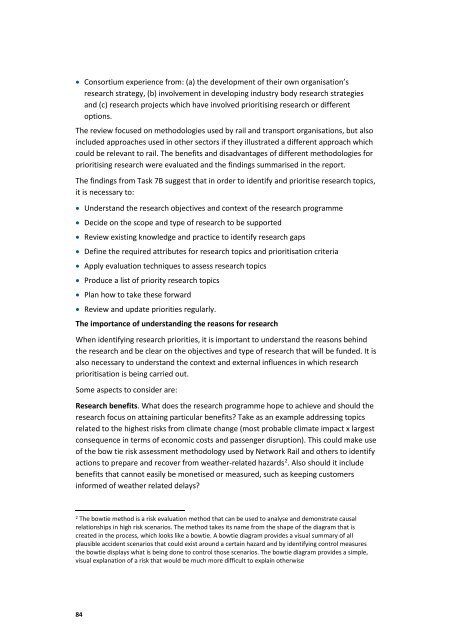Tomorrow's Railway and Climate Change Adaptation Final Report
2016-05-T1009-final-report
2016-05-T1009-final-report
Create successful ePaper yourself
Turn your PDF publications into a flip-book with our unique Google optimized e-Paper software.
• Consortium experience from: (a) the development of their own organisation’s<br />
research strategy, (b) involvement in developing industry body research strategies<br />
<strong>and</strong> (c) research projects which have involved prioritising research or different<br />
options.<br />
The review focused on methodologies used by rail <strong>and</strong> transport organisations, but also<br />
included approaches used in other sectors if they illustrated a different approach which<br />
could be relevant to rail. The benefits <strong>and</strong> disadvantages of different methodologies for<br />
prioritising research were evaluated <strong>and</strong> the findings summarised in the report.<br />
The findings from Task 7B suggest that in order to identify <strong>and</strong> prioritise research topics,<br />
it is necessary to:<br />
• Underst<strong>and</strong> the research objectives <strong>and</strong> context of the research programme<br />
• Decide on the scope <strong>and</strong> type of research to be supported<br />
• Review existing knowledge <strong>and</strong> practice to identify research gaps<br />
• Define the required attributes for research topics <strong>and</strong> prioritisation criteria<br />
• Apply evaluation techniques to assess research topics<br />
• Produce a list of priority research topics<br />
• Plan how to take these forward<br />
• Review <strong>and</strong> update priorities regularly.<br />
The importance of underst<strong>and</strong>ing the reasons for research<br />
When identifying research priorities, it is important to underst<strong>and</strong> the reasons behind<br />
the research <strong>and</strong> be clear on the objectives <strong>and</strong> type of research that will be funded. It is<br />
also necessary to underst<strong>and</strong> the context <strong>and</strong> external influences in which research<br />
prioritisation is being carried out.<br />
Some aspects to consider are:<br />
Research benefits. What does the research programme hope to achieve <strong>and</strong> should the<br />
research focus on attaining particular benefits? Take as an example addressing topics<br />
related to the highest risks from climate change (most probable climate impact x largest<br />
consequence in terms of economic costs <strong>and</strong> passenger disruption). This could make use<br />
of the bow tie risk assessment methodology used by Network Rail <strong>and</strong> others to identify<br />
actions to prepare <strong>and</strong> recover from weather-related hazards 2 . Also should it include<br />
benefits that cannot easily be monetised or measured, such as keeping customers<br />
informed of weather related delays?<br />
2<br />
The bowtie method is a risk evaluation method that can be used to analyse <strong>and</strong> demonstrate causal<br />
relationships in high risk scenarios. The method takes its name from the shape of the diagram that is<br />
created in the process, which looks like a bowtie. A bowtie diagram provides a visual summary of all<br />
plausible accident scenarios that could exist around a certain hazard <strong>and</strong> by identifying control measures<br />
the bowtie displays what is being done to control those scenarios. The bowtie diagram provides a simple,<br />
visual explanation of a risk that would be much more difficult to explain otherwise<br />
84


